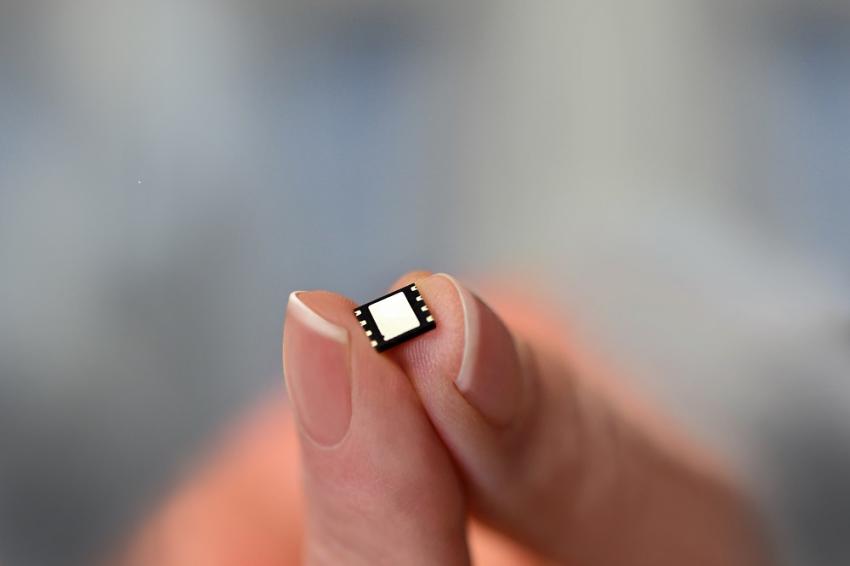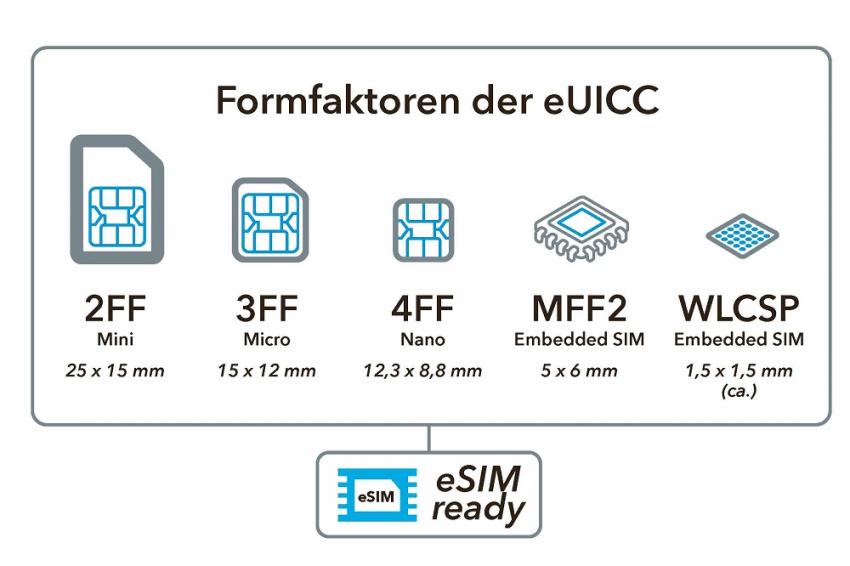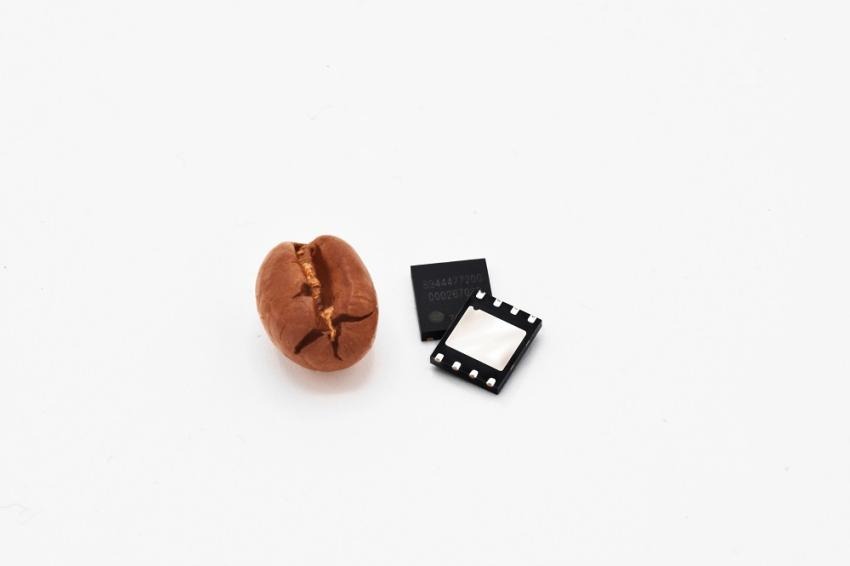How the eSIM is Revolutionising the IoT
Why there is no way around the eSIM with eUICC functionality for networked companies
Usually, the significance of technical developments for professional applications only becomes clear years after their invention. The Samsung Gear S2 smartwatch presented at IFA 2015 was the first widely distributed end device with integrated connectivity. Instead of the SIM cards familiar from mobile phones, an MFF2 chip permanently installed with the circuit board was used for the first time: The embedded SIM, or eSIM for short.
Due to the ever smaller and thinner end devices, the SIM card as a chip appears to be a logical continuation of the already existing SIM card formats. In fact, the eSIM is hardly relevant for the device design due to the elimination of the exchange drawer and opening mechanism. The chip is 6 x 5 mm in size and only a quarter as long as a mini-SIM card, leaving more space for batteries, interfaces or device cooling with the same housing size. In addition, the eSIM enables new classes of devices. This MMF2 chip is insensitive to vibrations and movement and can be sealed against moisture and corrosion. This makes the technology suitable for terminals used outdoors or in motion – a prerequisite, for example, in the automotive sector or for networked wearables.
Small electronic products worn close to the body can thus be constantly online without having to be connected to a smartphone or WLAN. Nevertheless, end devices with a known form factor for consumers with a permanently installed SIM card in the form of an MFF2 chip are already available on the market. At present, 20 IoS models and almost 50 Android terminals are offered with integrated eSIMs; the industry association GSMA speaks of 110 devices at present.
eUICC as a technology standard
Despite the obvious advantages of an eSIM as a soldered chip, the concept originally had a disadvantage. If it is a conventional SIM card, the device used is forever tied to a specific mobile network operator and its tariffs. If a change of tariff is necessary or desired, the terminal would have to be thrown away. But this is neither acceptable for the consumer sector nor for professional applications in IoT environments. Five years ago, product testers warned in the media against end devices with eSIM.
That is why eUICC was developed as a technology standard. eUICC stands for Embedded Universal Integrated Circuit Card. One of the key advantages of this component of a SIM card is that the original mobile network operator can be changed via a radio link without having to exchange SIM cards or the hardware. For Jean-Christophe Tisseuil, Head of SIM & eSIM at GSMA, this unrestricted interoperability of networked equipment and terminals is crucial: “The first requirement is something that is interoperable. The second is security and you have to network the end devices according to both principles. Because where there is no interoperability, there is definitely no business model.”
Today, the eSIM with eUICC has a virtual SIM card drawer. To be sure, a SIM card with eUICC functionality is initially equipped with a predefined international mobile subscriber identifier (IMSI). However, this so-called bootstrap profile can be changed without physical exchange. This means that the mobile phone provider and the tariff can be changed without touching the SIM card. eUICC is thus a technical standard with which IMSI can be managed, downloaded, activated, deactivated and deleted.
Future-proof with eUICC
For consumers, this is convenient when changing providers for obvious reasons. For networked companies, however, the use of eSIMs is essential in the future due to their economic scalability. This technology is fundamentally changing the mobile Internet of Things by greatly simplifying global provisioning and mobile machine-to-machine applications. Even the management of large SIM card inventories is no longer a cost factor. So, if one chooses a particular provider for the initial deployment of an IoT environment, this mobile operator may have tariff disadvantages in some territories when expanding internationally or, in the worst case, not operate a mobile network there. Via an eUICC functionality, it is possible to change the provider with low switching costs either completely or only per territory. eUICC can also manage multiple user IDs on a single chip. Thus, similar to a dual or multi-SIM solution, backup functions can be used and high roaming costs can be avoided.
Cost degression for international companies
In industrial production, eSIMs with eUICC have production cost advantages. In automotive production, for example, networked vehicles can be manufactured with just a single chip compatible with worldwide mobile networks. Instead of a barely manageable number of stock keeping units (SKU), a single component can be used. Local connectivity customisation is then carried out in the local markets.
“For enterprise customers, the eSIM means they can scale on a global basis and get consistent, high-quality connectivity services at the best price,” said Nigel Chadwick, general manager and vice president of connectivity at chipmaker ARM. “For manufacturers, it means they can develop it once and deploy it everywhere.”
eUICC: regardless of format
Although eSIM technology is a good ten years old, many companies still have high stocks of traditional SIM cards in traditional SIM drawers. Wireless Logic customer BBOXX, for example, operates solar energy plants and has activated almost 150,000 SIM cards in Africa alone. Nevertheless, it is possible to use eUICC by a one-time exchange of older SIM card stocks for eUICC cards in the same form factor. While not every eSIM automatically has to have eUICC functionality, every plastic SIM card can be an eUICC. So there are eUICC-capable SIM cards both as an eSIM in the form of the MFF2 chip soldered on the PCB and as a classic SIM card in 2FF (mini), 3FF (micro) or 4FF (nano) sizes. Interestingly, even the GSMA only uses the term eSIM, but usually means the eUICC technology regardless of the form factor. However, the management of tariffs and providers for eUICC-enabled SIM cards or eSIMs is different for consumers with end-user devices and enterprises with networked IoT assets. Private individuals actively request new tariffs - triggered, for example, by advertising campaigns or new price structures (pull model). They change and order tariffs and connections as needed, usually by scanning a QR code with their mobile phone. In the IoT/M2M sector, on the other hand, corporate customers do not actively manage the often company- and group-wide complex tariff structures themselves. The management needs for the mobile connections of an IoT company are mostly served by third-party providers (push model).
Access to 750 mobile networks worldwide
The network operators themselves have no vested interest in pushing eSIMs with eUICC technology, according to Dennis Paul of Wireless Logic Mdex: “Why should a mobile operator invest in an eSIM architecture when tariffs and providers can be easily switched? Network operators see in the eSIM above all the danger of losing customers at the click of a mouse and risking a higher churn rate.”
This conflict of interest is solved by specialised service providers for M2M mobile connections. “Wireless Logic, as a provider of operator-independent IoT connectivity, acts as a virtual network operator between corporate customers and the telecommunications companies,” says Dennis Paul. “We partner with all relevant providers and give our customers access to more than 750 mobile networks worldwide.” This allows IoT companies to choose from a wide range of providers and tariffs without complicated individual contracts. “As a service provider, Wireless Logic offers highly customised and industry-specific tariffs, with a single flat rate regardless of the mobile networks used,” says Wireless Logic’s IoT division manager Mdex.
For networked companies, this also means that they have only one contact person for all territories and business areas. Again, there is only one point of contact for support issues such as faults or the failure of a particular network. "Networked companies receive a full-service package for M2M and IoT connectivity, from data tariffs and professional industrial router hardware to a dedicated SIM management platform," explains Dennis Paul. “For telecommunications companies, as a virtual network operator, we open up new customer groups similar to a retail channel, which can be served in a much more demand-oriented manner. For both our customers and the mobile companies, this is a classic win-win situation.”
The eSIM is followed by the iSIM
Boundless connectivity and increasing miniaturisation of connectivity are already firing the imagination of hardware manufacturers. The interference-free and secure transmission of sensor data will enable a multitude of new end devices and systems, for example in the medical sector (e. g. implants, vision and hearing aids), in mining (e. g. smart drill heads) or in the security sector (e.g. location or origin localisation). The iSIM is the next smaller but even more powerful version of the eSIM. Unlike the eSIM, it is not a chip embedded on the board with its own processor. Rather, the iSIM is integrated directly into the device processor without its own processor. The 1.5 x 1.5 mm small iSIM thus saves even more space and energy, but just like the eSIM, it cannot be physically updated.
These advantages should lead to a large spread of global networking. SoftBank founder Masayoshi Son predicts that there will be one trillion IoT connections by 2035 - that's more than 100 connections for every person on earth. “There is therefore no way around the eSIM with eUICC functionality for connected companies if they want to remain competitive,” explains Dennis Paul. “As a virtual network operator, we can help make existing IoT environments fit for the future with eUICC.”
Author
Christoph Holowaty, Marketing Manager









